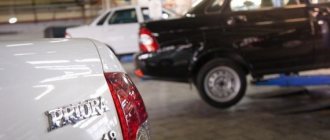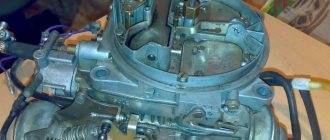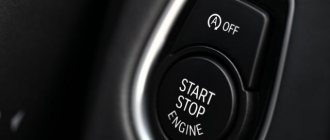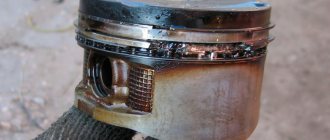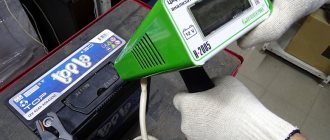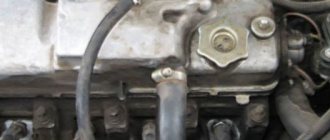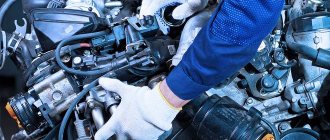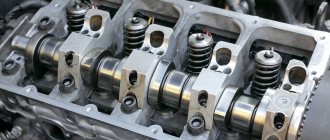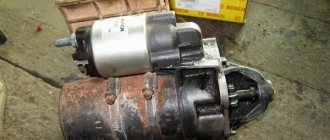Causes of malfunction
Before we begin to study the causes of the malfunction, we remind you that hereinafter we are talking about the crackling noise of the starter, which is most similar to the loud rattling of the contacts of an electromagnetic relay. If you hear an unpleasant metallic grinding noise from under the hood, then it appears due to poor engagement of the overrunning clutch (starter Bendix) with the flywheel teeth - that’s a completely different story.
Most often, the starter crackles when you turn the ignition key for three reasons:
Low battery
To understand the cause of the crackling noise due to a discharged battery, let's remember the starter device. When you turn the ignition key, the voltage from the on-board network is supplied to the coil of its solenoid relay. The electromagnetic forces that appear in this case cause the armature of the device to move. It closes the power contacts that connect the starter motor to the battery, and in addition, causes the Bendix gear to engage with the flywheel.
When the battery is discharged, its energy may be enough to attract the metal core - cranking the crankshaft is out of the question. As soon as the starter contacts close and power is supplied to its electric motor, the voltage drops to such an extent that the electromagnet is unable to hold the metal core. Under the action of the return spring, it tends to take its original position and opens the power contacts. The restored voltage contributes to the repeated retraction of the anchor, and the situation is recreated many times.
To make sure that the culprit of the problem is a deep discharge of the battery, just turn on several consumers (lighting, electric heater motor, etc.) and press the sound signal. The latter will either not turn on at all, or will be heard with wheezing, reduced amplitude or attenuation.
Poor engine ground contact
The picture of what is happening is practically indistinguishable from the case discussed above, with the only difference that the test for battery discharge ends with a negative result - all consumers, including the sound signal, are working at full strength.
At the same time, it is very simple to determine that the cause of the malfunction is poor contact between the battery and the engine - just pay attention to the oil pressure warning lamp, which is located on the instrument panel. If the voltage in the car’s on-board network is below normal, then turning the ignition switch to the “Start” position will lead to a gradual attenuation of the brightness of the warning lamp (like all others).
In the case where the cause of the crackling sound of the starter solenoid relay is a bad ground, an attempt to start the engine will lead to its complete extinction in time with the clicks of the solenoid relay. At the same time, other indicators practically do not change the intensity of the glow.
Everything is explained very simply - the “mass” of the oil pressure sensor, as well as the starter, is the housing. Therefore, as soon as the electrical contact between the engine and the battery is lost, both of these devices stop working synchronously.
Open or shorted starter relay winding
Another reason why the solenoid relay cracks is an interturn short circuit or a break in its holding winding. In other words, the efforts of the electromagnet become insufficient to keep the power contacts of the starter relay in the closed state and engage the overrunning clutch gear with the flywheel ring gear. Under the action of the return spring, the bendix tends to take its original position, and the contact pad located on the armature opens the electrical connection. After this, the retractor winding turns on again and the situation repeats itself many times, which causes the crackling noise.
to determine that in this case the starter solenoid relay has failed by the behavior of the warning lamps located on the instrument panel. At the moment when the loud clicks of the starter are heard, their brightness does not change - the switching of the starter motor occurs for such a short time that the battery voltage practically does not drop.
Something else useful for you:
- The starter does not turn the retractor, but clicks
- How to check the starter solenoid relay?
- Why doesn't the car start, but the starter turns?
The most common reason is the battery.
Problems with starting a Nissan occur mainly due to a malfunction of the electrical part . If it is impossible to start the X-Trail, then you should perform the first-priority diagnostics step by step:
- A common cause of problems with starting the engine (the starter does not turn) is the battery charge is too low . Most often, the battery is discharged in the morning, especially in the cold season, or when lighting devices or other consumers of electricity are left on at night.
- Inspect fuses. After voltage surges they fail. If the battery is in order, then to the right of the engine under the hood you need to check the fuse box located there.
Nissan X-Trail engine compartment fuse box - Check the condition it is in wiring. It is possible that the contacts in the Nissan electrical circuit have oxidized and weakened due to constant vibration. First, the battery terminals are inspected (for oxidation), then all electrical wiring is examined to detect possible cable breaks, melting, corrosion.
Oxide on the battery terminal Nissan X-Trail
If the X-Trail does not start and a fault is found in the electrical wiring, it must be repaired immediately, as this may lead to a fire.
After starting a cold engine, a crackling or knocking noise is heard: possible causes
Let us immediately note that the appearance of extraneous noise often indicates some problems, but this does not always immediately indicate a serious breakdown. One way or another, over time, wear in the engine progresses, the gaps between parts increase, the internal combustion engine gradually becomes dirty, which impairs the performance of the lubrication system and leads to increased noise during operation of the power plant, the appearance of crackling or knocking.
So, among the main causes of cod, experts identify:
- Violation of thermal clearances of valves. If the engine is not very worn, then this is a common reason that indicates the need for valve adjustment.
- The next reason is problems with hydraulic compensators. Typically, the crackling sound of hydraulic compensators is audible when cold, but disappears after warming up. Such noises indicate both possible wear of the hydraulic valves themselves, dirty engine oil and oil filter, as well as a decrease in pressure in the lubrication system. In such a situation, you need to start by changing the oil and filter, you can also use a separate additive against the noise of hydraulic compensators.
- In some cases, knocking and crackling noises when cold appear as a result of increased gaps in the area of the main bearings.
While the oil is cold, knocking noises are heard after starting the internal combustion engine, and as the lubricant thins out, the oil pressure increases and the knocking noise disappears. At the same time, it should not be ruled out that the problem may be that the oil pump itself has noticeably lost its performance, the oil receiver mesh is clogged, etc.
- Often the cause of a rattling sound in the engine after starting is the timing belt. If the gaps in the beds are increased, extraneous noise can be clearly heard on a cold engine.
- The appearance of a somewhat muffled knock may well indicate that the piston is defective or worn. Most often, the pistons dangle in the cylinder, knocking with the skirt. In this case, the piston rings usually fail as well. The problem may progress, as the piston skirt simply breaks off further.
- Quite often, a crackling sound when cold may have nothing to do with the engine itself. More precisely, problems may arise with the drives of attachments (generator, power steering pump, air conditioning compressor, timing chain or belt, etc.).
It is quite obvious that it is impossible to ignore extraneous sounds in the engine. If a cracking, knocking or other extraneous sound is noticed, the car needs professional diagnostics. We also note that the development of engine technology and the complication of individual systems often leads to a decrease in the reliability of the latter. Let's look at a similar situation using a specific example.
The starter and retractor relay clicks, what is the reason?
If the starter clicks on a VAZ 2114 and does not turn, then everything immediately becomes clear . These clicks come from the solenoid relay, but this does not mean that you need to change the starter solenoid relay. Current flows to it, which is why it clicks.
If these devices click, then this is not bad, because if there are clicks, then these devices are operational or partially operational.
In most cases, solenoid relays use an electromagnetic method to connect contacts.
When voltage is applied, the contact terminals receive charges with opposite poles, so they begin to attract and when they touch each other, they create a clicking sound.
In order for the engine to start, you need to make sure that these components are in good working order:
- the battery is charged with well-connected terminals;
- The ignition switch and its contacts must be in order;
- the starter relay, the solenoid relay and the starter itself.
Video tip: The starter clicks but does not turn:
Starter
There are several reasons for this behavior. In order to understand the reasons in more detail, you need to know the starter design and operating principle. It consists of an electric motor, on the shaft of which an overrunning clutch with a drive gear is installed. In everyday life, the clutch and gear are called bendix. The design also includes a starting relay with a solenoid. This design is called a “traction relay”. It is connected to the clutch by the starter activation lever. This design works as follows
. When turned on, the electric motor begins to rotate the bendix. At the same time, the traction relay, having activated, moves the overrunning clutch forward using a lever. As a result, the gear meshes with the teeth of the flywheel and spins the engine. After the engine starts, the overrunning clutch is activated. This protects the starter from damage. When the power supply to the device is turned off, the relay stops working and the starter bendix returns to its original position. Passenger car starters usually use a roller-type overrunning clutch.
There is only one reason for the grinding noise at startup. For some reason the Bendix cannot fully engage the flywheel. Therefore, when starting the starter, a grinding sound of skipping teeth occurs. This problem needs to be fixed as quickly as possible. Otherwise, the flywheel and starter gears may be damaged. You need to check the following points:
- First, check the starter mounting. Sometimes vibration can cause the mounting bolts to come loose. In this case, the starter becomes warped and the gear loses full contact with the flywheel. In any case, remove the starter and check the condition of the bendix;
- Sometimes the problem can be caused by gear wear. In this case, the starter's performance decreases. When starting the engine, you will hear the grinding sound of the bendix moving around. Over time, the starter will not be able to turn the flywheel at all. After removing the part from the machine, you can see the gear wear with the naked eye;
- Sometimes the Bendix does not move well along the shaft and simply does not reach the flywheel. In this case, remove it. You need to coat the shaft with any motor oil (5w30 or 5w40 or whatever you have on hand). Also check the operation of the traction relay.
there is a problem somewhere in the starter
A crackling sound when starting can also occur due to problems with the starter's power supply. It appears when the positive wire is loosened. If there is poor contact, a spark discharge occurs, which is what produces a crackling sound. Check the wire. Tighten it if necessary. Flywheel
. The cause of the grinding noise may be in the engine. If the flywheel teeth are worn too much, they cannot form full contact with the starter gear. As a result, you can hear an unpleasant grinding noise. It is advisable to replace the flywheel. Otherwise, the wear of the bendix will increase and you will have to change it regularly. Since we are talking about the flywheel, read our two materials on this topic:
- “Pros and cons of a lightweight flywheel”;
- “Independent replacement of a dual-mass flywheel with a single-mass one.”
Roller mounting bolt (timing) Conclusion
Causes of extraneous sounds in the engine compartment during or immediately after starting the engine
Worn generator bearings
If you hear a whistle and other extraneous sounds when starting the engine, this may indicate various problems associated with its operation. As a rule, these sounds are not so much dangerous for the unit as they are annoying to the driver himself. However, if squeaking, clicking, or knocking noises from the engine occur, the problem must be addressed immediately.
Belts
So, if a whistle appears when starting the engine, then one of the most common causes of this problem is belts. The squealing noise may be due to wear on a particular belt or poor tension, and it may become louder as the crankshaft speed increases. But sometimes when you press the gas, the whistle may disappear altogether. If you hear a whistle when trying to start the engine, then first of all you need to check the tension of all drive belts.
If during the diagnostics you notice that one of the belts is loose, this in turn can lead to its slipping, which can lead to the appearance of sounds uncharacteristic of engine operation. In this case, tightening the strap can solve the problem. Remember that slipping can also be caused by dirt and engine fluid that gets on the straps. If this is the case, then the cause of the oil leak must be solved before replacing the belt; of course, you can try to clean it, but experts recommend changing them anyway (the author of the video is the channel In Sandro’s Garage).
As practice shows, most often ringing and squeaking when starting the engine is caused by the alternator belt, and extraneous sounds disappear after increasing the engine speed. This problem is fraught with insufficient battery charge, which, in turn, can lead to multiple consequences. Moreover, if the belt breaks, the battery simply will not be able to charge while the engine is running. As a result, a corresponding low battery indicator may appear on the dashboard; if this happens, you need to check the condition of the belt itself.
In some cases, the problem may be with the timing belt, and the consequences of such a malfunction will be more serious. The appearance of extraneous sounds may be due to wear of the bearings. If the strap itself breaks for some reason, this can cause the valves to bend, and such repairs, in turn, require large financial costs. Check the condition of the belt itself - there should be no signs of damage, peeling or cracks. If they are present, the strap must be replaced.
Rollers and bearings
The appearance of unpleasant rattles, pops and other third-party noises can occur due to the fault of bearing devices, as well as rollers. The engine design uses more than one bearing and roller, so it can be difficult to find the cause. From a normal whistle, the sound when rollers and bearings wear out will be lower; as a rule, it appears when the engine is running at idle speed. Moreover, when they increase, it will either disappear completely or be quieter. Worn rollers with bearings must be replaced before a more serious problem occurs (video author - IB Channel).
Intake system malfunctions
Grinding and popping noises, as well as crackling noises when starting the engine, sometimes occur due to malfunctions in the operation of the intake system. Of course, you should move on to this option when you are sure that the bearings, rollers and belts are working properly.
So, what malfunctions are typical for the intake system:
- Throttle valve. This unit sometimes jams, as a result of which it creates specific turbulence in the air flow. If the appearance of grinding and popping noises, as well as whistling, is caused by this particular problem, the damper must be completely flushed. Please note that to most effectively clean the unit, it will need to be completely dismantled.
- The reason may also be the intake valve, which is responsible for the circulation of crankcase gases. If it becomes clogged, it will prevent normal circulation of hot air; therefore, due to very high pressure, engine fluid may be squeezed out of the seals. To get rid of such a malfunction, the valve will need to be cleaned, but to do this it must first be removed. Depending on the design features of the engine, it can be located either on the crankcase ventilation pipe or on the valve cover. If the valve itself is made of metal, any substances that will not scratch the surface can be used for cleaning. If the device is made of plastic, then it is better not to use aggressive agents.
Turbine malfunctions
Most modern cars are equipped with turbochargers, the purpose of which is to increase engine power, as well as improve the driving characteristics of the car as a whole. However, it is another powertrain component that can cause knocking, grinding, and popping noises. If the engine starts and a knocking and grinding noise is heard, then there is a possibility that this problem is caused by an air leak in the place where the turbocharger and the power unit connect. As a rule, the appearance of sounds uncharacteristic of internal combustion engine operation indicates a failure of the turbocharger. This malfunction is more typical for diesel units (the author of the video is the MZTk Turbocom channel).
Starter
If you clearly hear a grinding noise, then there can only be one cause of the malfunction - the bendix, which is one of the main elements of the starter, for some reason cannot engage with the flywheel. The grinding noise itself appears as a result of skipping teeth. It should be noted that such a breakdown must be eliminated as quickly as possible, otherwise there is a possibility of damage to the gears of both the flywheel and the starter unit.
The following elements are subject to diagnosis:
- First of all, you should diagnose the mounting of the device - in practice, due to driving on uneven roads, the bolts that secure it may become unscrewed. This leads to the fact that the mechanism will be skewed, accordingly, the gear will lose contact with the flywheel. You need to dismantle the starter assembly and diagnose the condition of the bendix.
- If the problem lies in gear wear, then the efficiency of the mechanism will be significantly reduced. The grinding noise itself will appear as a result of the bendix bypassing, and if you do not deal with this problem as quickly as possible, the starter device may eventually stop turning the flywheel altogether. After dismantling, if the gear is really worn out, you will be able to see it without the help of specialists.
- There is a possibility that the bendix does not move well along the shaft and is not able to reach the flywheel. Try to dismantle it, and lubricate the shaft itself with engine fluid, then reinstall it and re-check the operation of the unit. It would not be superfluous to carry out diagnostics of the traction relay.
1. New and worn gear
2. Worn out bendix
Doesn't start and squeaks in the choke area
9 hours ago, Vadim said:
Unsubscribe later what is the reason.
I'm unsubscribing.
The reason is unknown, but there is an assumption.
Now I will describe in detail the story of today’s trip to the OD.
I arrived at the OD half an hour early so that the car would sit like she did for two days and not start. After 30 minutes, an OD officer came and sat in it and it started right up. Fortunately, the check light was on, so there was a reason to still get her diagnosed. We washed it and after washing it started. We removed the errors, and about 12 of them fell out. The main ones that could affect the start are the throttle control and the car tire. They began to say that such a number of errors could have occurred due to overvoltage of the on-board network. Reset to zero. We start the car again and it starts. It no longer gives errors. Kind of fine. I do not agree with this diagnosis, because two days cost me a lot of nerves. And I suggest starting the car in 1.5 hours. Time has passed, we start it up and it starts up again as if nothing had happened and there are no errors. No, I say, I’ll sit all the way until it starts. For the first time in my life I dreamed that the car wouldn’t start. Paradox. After another 30 minutes I’m standing near the car, an engineer comes up to drive my car away to make room for another one and it won’t start. The moment of truth has arrived. Scanning. 8 errors, two of which are repeated in throttle control and the car tire. They reach a verdict. Something is wrong with the BSM unit (see photo). It is located behind the battery under the air pipe. But the blocks are not in stock either in OD or in the main Nissan of Russia itself. If you order, then wait 3 weeks, but to order it, you need to be 100% sure that the problem is there. Since this is their first time. This block contains several relays that are not removable; if the relay is covered, the entire block is replaced. Its cost is 24,000. Cool. New technologies. Soon the fuses will be non-removable, one has burned out, change the entire fuse block.
And here is the most interesting thing. In order to exclude or confirm this assumption, a BSM donor is needed. Put it on my car and try to start it and if it doesn’t start again, then the problem is not in the block, but they will clear the errors again and will think again.
Where can they get a donor block? From a new car, but they are not there, for obvious reasons. From a car that is sold by trade in. But they don’t have such cars for trade-in. From a car that will come to them for maintenance. But lately such cars have not come to them for maintenance, since quite a lot of time has passed since the car was removed from sale and many have passed the warranty period, after which, as a rule, they do not come to the OD for maintenance. Moreover, the car must arrive with keyless start and manual transmission, since the BSM unit is different, depending on the configuration.
Funny. The main thing is that they admitted that there is still a problem, but what? They say: “Try to find the BSM block yourself somewhere. Borrow from disassemblies for diagnostics, and then pay them back.”
In general, I didn’t close the outfit. Let them search, but without a “donor” this could take a very long time. Good people, please respond. We need a donor. Blood type: "Keyless start and mechanics."
Modified June 2, 2021 by medvedev921
Diagnostic and troubleshooting methods
Many car enthusiasts, leaving home in the morning and starting the vehicle engine, have encountered a grinding and crackling sound when starting up. In this case, the malfunctions are different and it is worth understanding what sound means what.
Starter, flywheel and solenoid relay
Perhaps it’s worth starting our consideration with the fact that a grinding noise appears during the start-up of the power unit. As it was found out earlier, the issue here is in the starter or flywheel. So, if the grinding noise continues until the engine starts, this is due to wear on the bendix or flywheel crown.
To be more precise, the teeth of one or the second element are worn out, and the part does not adhere well to the part. Also, the issue may be in the solenoid relay, which does not fully pull the bendix, which does not grab the flywheel.
To eliminate the malfunction, it is necessary to dismantle the starter and inspect the condition of the bendix, namely its teeth. If there is characteristic wear in the form of “licking” of the teeth, then it is recommended to replace the part. But that's not all. Also, since the starter has already been removed from the vehicle, it is worth checking the solenoid relay.
Also, this malfunction and the grinding effect can be caused by the fact that the flywheel crown is worn out. It is worth noting that not all engines have a dismountable flywheel, so the entire assembly part is often replaced. Thus, the wear of the teeth leads to the fact that the Bendix cannot catch on them and turn the crankshaft. It is at this moment that a grinding noise occurs in the engine compartment.
Cracking - where to run and what to do
A cracking sound is a malfunction in the crank mechanism or cylinder head. So, first of all, it’s worth checking the cylinder head. Malfunctions must be looked for in the guide bushings, where wear may have occurred and the valve simply dangles, and hydraulic compensators can also knock and crack, which should be replaced because they have exhausted their service life.
The second place to pay attention is the cylinder block and its elements. So, a cracking noise can be caused by a lack of lubrication (engine oil), as a result of which the oil scraper rings scratch the cylinder walls
Also, special attention should be paid to the main and connecting rod bearings, which can rotate due to wear on the part of the block itself.
The last element that can also cause cracking and damage the cylinder walls is the connecting rod bushings. They could become loose and go beyond the pressing limits. In this case, the danger is that the bushings can damage the cylinder walls so much that the only solution is to line the block or replace it.
Conclusion
Grinding and crackling noises in the power unit indicate that some engine parts have failed. So, the grinding noise is accompanied by a malfunction in the starter or flywheel. As for the crackling sound, the situation is much more complicated - most likely the problem is hidden in the crank mechanism or in the cylinder head.
If such malfunctions occur, it is recommended to contact a car service as soon as possible, so as not to cause more trouble than already exists.
Causes of extraneous sounds
Causes of extraneous sounds when turning the steering wheel
There are many reasons that can cause noise, among them the most common are:
- Steering rack malfunction . Its wear or loosening.
- Steering column and problems associated with it.
- Malfunctions of suspension elements . These could be shock strut support bearings that require replacement, or ball joints.
- There is a problem with anthers . After they rupture, water and dirt enter the drive mechanism and cause it to malfunction. Therefore, a torn boot should be replaced immediately.
Finding the source of the whistle
Check what is the most likely cause of the sound. Determine if the whistle is heard only during startup. It may also manifest itself in other situations. Also check if the sound only occurs when you start the engine at low temperatures. It can also be heard when starting in warm conditions. Make sure the car is in neutral or park and have someone start the car while you stand outside with the hood open. Listen carefully and try to determine the place from which the creaking is heard.
Features of checking the performance of elements of the starting system of a car engine
After visual inspection of the condition of the starting system parts, they begin to dismantle the starter to test its components:
- It is possible to determine how worn out the brush assembly is only after disassembling the starter housing. Despite the long service life of the brushes, they still wear out. At the same time, their development on some starter models does not allow the traction relay to be activated. In this case, the clicks it makes will not be heard.
- Burning of the windings on the coils can be easily determined both visually and by the presence of a burning smell. Since it makes no sense to restore their functionality, you will have to replace the starter.
- It is possible to perform a traction stress test without its housing. To do this, you need to close the two large terminals on the relay using a screwdriver, being careful not to catch the housing elements. The presence of problems with the retractor will be signaled by the beginning of shaft rotation. Note that one of the unpleasant consequences of this is the burning of the relay contact groups. Since they contain a special protective coating to prevent damage, it is not recommended to clean carbon deposits from them. In this case, only a complete replacement of the traction rod is indicated.

